The stove stinks of gas: reasons for the smell of gas from the oven and burners and tips for eliminating them
The simplicity and ease of use of gas stoves has been appreciated by many users.Thanks to the stove, it is easy to prepare the most complex dish. But sometimes users notice that during operation there is a smell of gas from the stove - the smell can be felt while the burners, oven are operating, or after turning off the appliance. But what is its appearance connected with and what is it evidence of?
In this article we will look at why gas leaks occur and talk about how to troubleshoot problems yourself. We will provide the presented material with visual photos and thematic videos.
The content of the article:
Features of operation of a gas stove
Professionals know that gas supplied through centralized pipelines has no odor. It is given an unpleasant aroma using the odorant ethyl mercaptan. This is done for security purposes, as it allows any user to promptly detect leak, and, as a result, avoid poisoning or explosion.
When the gas in the burner or oven is ignited, a small part of the fuel can enter the room, creating the feeling of a leak. However, this situation is safe, and the smell quickly disappears.
If an unpleasant aroma is constantly felt during cooking, you should think about the possibility of depressurization of the system and the need for repair work.
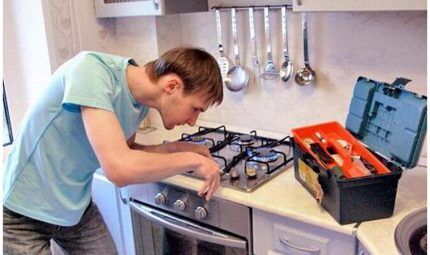
Sometimes users do not understand why the burner or oven is on fire and smells of gas.
In this case, the cause of the leak may be:
- loosening of the connecting hoses;
- presence of deformation, cracks on gaskets;
- the appearance of holes in hose during long-term use;
- loosening of the gas valve;
- lubricant drying out;
- wrong slab installation.
Before raising the alarm, it’s worth figuring out whether you really smell gas. For example, manufacturers treat burners with a special composition, so when a new gas stove is operating, an unpleasant odor is often felt. It appears when the lubricant burns out. After a couple of weeks of use, the smell disappears without outside intervention.
Sometimes the cause of unpleasant odors that appear during operation of a gas stove is the carelessness of installers. They leave pieces of paper, rags, and plastic in the inside of the device. Under the influence of high temperature, the material gradually burns out, emitting an uncharacteristic aroma.
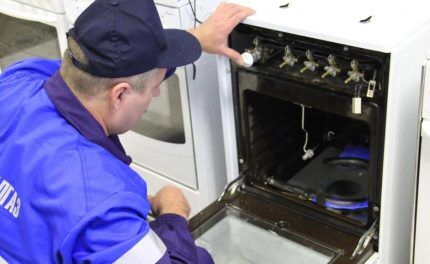
When there is a constant smell of gas coming from the oven, or an unpleasant odor is felt when turning on the burners, you should contact a specialist. call the gas service. If you want to fix the problem yourself, you need to immediately start searching for the leak.
Self-diagnosis of faults
To figure out whether gas smells from the oven or the stove, you need to determine where the leak occurred.
Having determined where the gap is, it will be easier to describe the malfunction when calling a specialist. This will help the technician obtain the spare parts necessary for repairs.
If there is an unpleasant odor in the room, it is important to understand the nature of the problem:
- gas enters the room even when the stove is not working;
- an unpleasant odor appears after turning on the device;
- gas oozes from switched-off burners when neighboring ones are working;
- An unpleasant aroma appears only when the stove is lit.
Most defects are eliminated by replacing a hose that has lost its seal, a worn gasket, or a failed part. However, it is better to entrust the work of restoring the functionality of the stove to professionals.
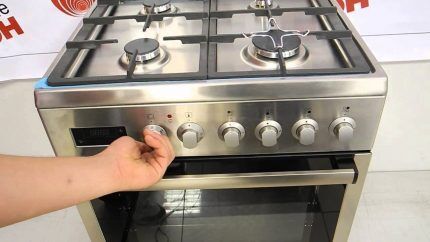
When a gas panel is found to be leaking gas during operation, it is important to quickly locate the leak.
You can determine it yourself in several ways:
- Aurally — a characteristic whistle appears at the point of depressurization.
- By smell — unpleasant odors intensify as you approach the leak site.
- INvisually - To determine the place from which the gas is coming out, use soap suds. To do this, soap is diluted with warm water. Thick foam is applied to the joints of hoses, pipes, taps, and threaded connections. When you turn on the device, soap bubbles will appear at the leak site.
- With the help of specialized sensors. Compact devices analyze the composition of air.In case of serious deviations, they emit a sound or light signal, and some models equipped with shut-off valve, block the flow of gas.
When the presence of a gas leak is confirmed and its location is located, it is important to ventilate the room well and report the problem to the gas service.
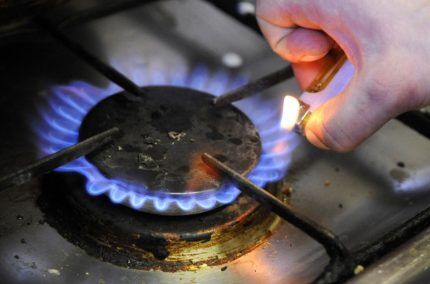
While you are waiting for gas service specialists, it is not recommended to use electrical appliances or turn them on/off.
Troubleshooting a gas stove
Before starting repairs, it is important to know that all gas fittings are made of alloys that do not produce sparks upon contact. During restoration work, it is worth using similar materials.
The tools you will need are pliers, an adjustable wrench for the stove and valve, and a gas wrench.
Problem #1 - burner malfunctions
When the smell of gas appeared as a result extinguished flame, you must immediately close the valve and ventilate the room. This situation is considered an emergency, so you need to immediately open the windows wide. When the burner has cooled down, it is important to thoroughly blow it out and clean it of any remaining food or grease.
During operation of the stove, carbon deposits accumulate on the burners, which can cause flame yellow tint. This can be misleading and create the appearance of a malfunction where there is none.
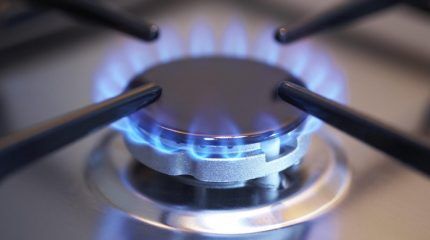
After thoroughly cleaning the burner, you need to put it back in place, light it, and check its functionality.
If the cause of the malfunction is any defect, it is worth replacing the burner with a new one.
Problem #2 - broken connecting hose
Hoses used to connect gas are sold at specialized retail outlets. Visually, they differ from the others by their bright yellow shell.
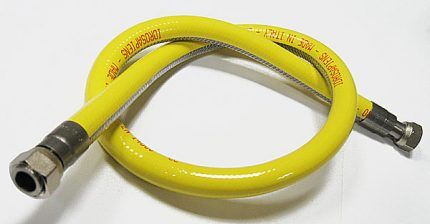
When the cause of the leak is a crack in the hose, it is worth replace it. After all, carrying out repairs will provide a short-term effect and the unpleasant smell will very quickly appear again.
Problem #3 - Leakage in the stopcock area
To check the operation of the unit, it is necessary to apply a soap solution to the pipe. If a leak is detected, you must immediately shut off the gas supply and call professionals. If there is a new valve, flax tow, the master will promptly will replace the gas valve.
Once installation is complete, the connection is tightened until the valve is in the desired position. Correct installation is determined by repeated application of the soap solution.
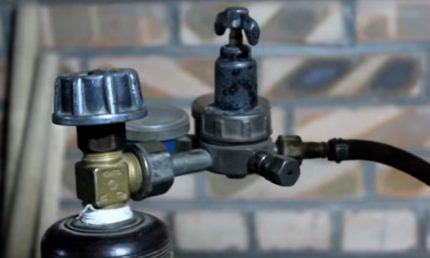
To extend the service life of the connection, it is painted with oil paint. After the composition dries, a dense film is created that can reduce the likelihood of leakage.
Conclusions and useful video on the topic
You can get detailed instructions on detecting gas leaks by watching the video.
To summarize, it is worth noting that the cause of the unpleasant odor that appears during use of a gas stove may be lubricant applied by the manufacturer or a leak of blue fuel.
If the composition applied to the components of new equipment burns out over time, then the gas entering the room may cause poisoning or an accident.
At the first sign of a problem, you should contact a professional. You should troubleshoot problems yourself only if you have specialized knowledge and experience working with gas equipment.
Have you experienced a gas leak and want to share your experience troubleshooting the problem with other users? Share your experience with our readers, leave your comments in the block below, ask questions to our experts and participate in the discussion.




Unconvincing and even ridiculous statements are that during combustion gas escapes and smells from leaks in the hose and connections. It would go away even before the burner was ignited if the inlet valve was open. When there is a crack in the hose, how can we talk about repairing it with a short-term effect? Just replace it of course!
We bought a gas stove just yesterday, the oven is also gas, when I light it it starts to smell like gas, will this go away? The hose is all intact, we installed it on the gas cylinder and when we turn on the comfort gas, it goes peck prick prick, that is, as if inside the cylinder, what could it be?